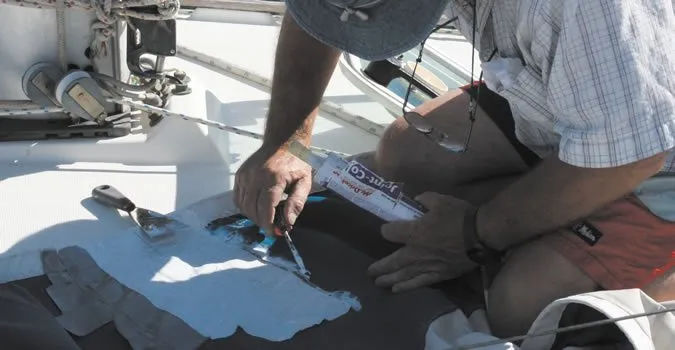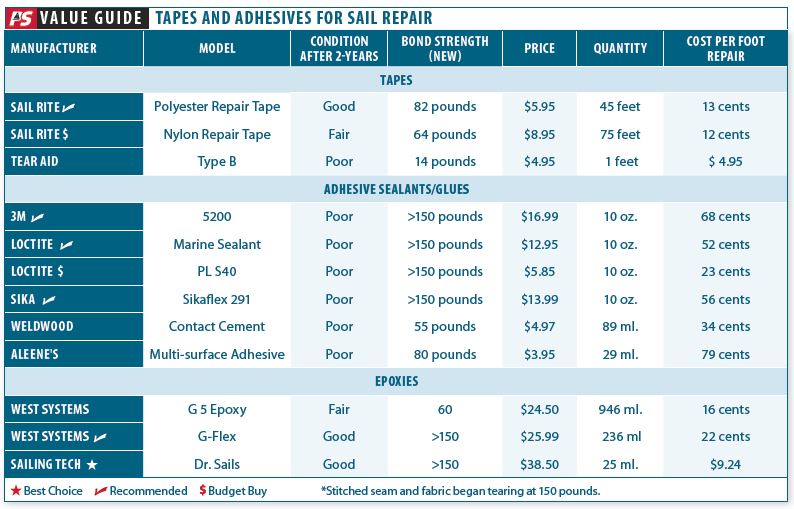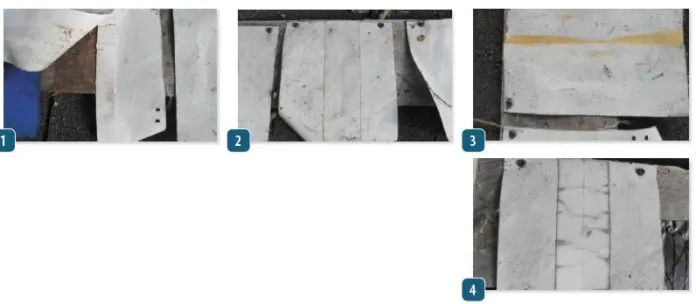Often an old sail won’t hold stitches, and some sailors hate to sew. A number of products proved strong enough and flexible enough to make serviceable repairs. In Stitch-free Sail Repair, (see November 2017) we reviewed repair tapes, epoxy, polyurethane, and a few other common adhesives for usefulness as no-sewing options for sail repair, and in September 2017 we reviewed options for Sunbrella repair. After two years in the Maryland sun, the rankings have changed slightly.
Polyurethane Adhesives
To our surprise, all of them, including highly-rated products from 3M and Sika, failed completely, peeling apart under their own weight. This should not have been a surprise, since we have long known that polyurethanes make poor glazing adhesives unless the surface is properly primed with a UV blocker.
Sika specifies a UV-blocking primer when used as a glazing sealant. Although the sealants resist UV, the bond is extremely vulnerable when exposed, and the UV coming through the cloth destroyed the bond. In all cases, the non-exposed side was still tightly adhered to. The Sunbrella samples displayed a different trend, with the polyurethanes holding up well.
The difference, of course, is that Pacific Blue Sunbrella blocks UV. We did not test 3M 4000UV or Sika 295UV, and now it seem likely they may have done better; we will follow-up in a future investigation. Remember also that two years in the sun is a very long time for sails, equivalent to sailing around the world twice.
Bottom line: Recommended for Sunbrella repair and for temporary repair of sails. UV resistant blends might last longer.

Contact Cement
Both Weldwood contact cement and Ailenes failed completely, the UV cooked the adhesive until it was crumbly. They did better on Sunbrella, but the exposed cement was still crumbly and no longer adhering
Bottom line: The repairs may be easy, but they wont last.
Epoxy
West Systems G-Flex was still strong, although in this application is a little stiffer than we would like. Dr. Sails from Sailing Technologies was also still strong and remained flexible.
Bottom line: Recommended for polyester sail repair and acceptable for Sunbrella repair.
Tapes
The bond of Bainbridge Polyester Sail Repair Tape to sailcloth seems to get better with time, welding itself to the sail. On Sunbrella it was peeling off a little. Nylon Sail Repair Tape (also Bainbridge) is more vulnerable to UV and was starting to look sunburned, but the bond was still sound. However, since this product is typically used on nylon spinnakers, the UV resistance should be more than adequate.
We’ve flown old chutes patched up with yards of this stuff, and they always seemed to fail somewhere other than at the repair. Tear Aid Type B was distorted and peeling off.
Bottom line: Bainbridge Polyester Repair Tape is recommended for working sail repair, and Bainbridge Nylon Repair Tape is recommended for spinnaker repair. These belong in every sail repair kit. Apply to both sides and rub down hard.
So there you have it. Epoxies and polyester tape worked out well on polyester sails, nylon tape for chutes, and polyurethanes and Dr. Sails for Sunbrella.
Polyurethane failed on sailcloth in the long term, but truly, our test ran longer than required for most repairs. UV protected blends might do better, and be worth a try.
We have started testing materials for laminate sail repair. Since many of the repairs we have been making are along stitching lines, it seems clear that adhesives may offer the better solution. Dr. Sails looks strong, and we have some interesting film and reinforced tapes in the field. Stay tuned.


































